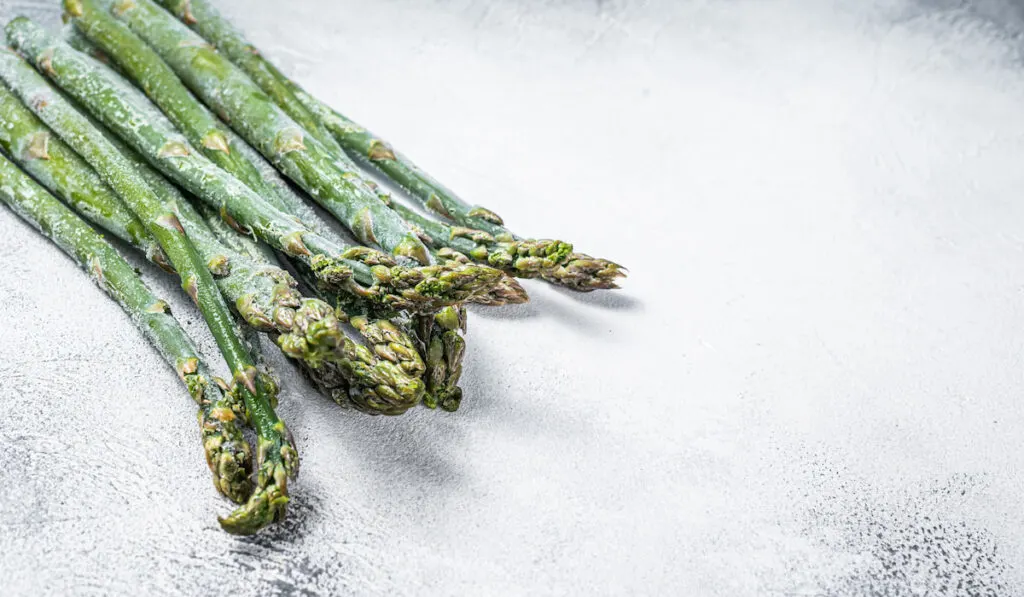Asparagus is usually a vegetable that people eat only occasionally. It’s certainly not as common as, say, broccoli, lettuce, carrots, cucumbers, and other staples. Usually, we eat asparagus for a nice meal out at a steakhouse, or when it goes on sale. When it’s out of season, asparagus can be fairly pricey, so it’s not exactly an everyday item.
When a vegetable costs a bit much, you want to make sure you use it. Unfortunately, sometimes you see asparagus for sale and you buy it without knowing when you’re going to get around to cooking it. When you finally take it out of the fridge, it may look a bit off or you give it the sniff test. You may not know whether it’s still good to eat.
How can you tell if asparagus is bad? It can be harder because you’re probably not going to see signs that it’s bad the way you would with something like fruit.

We’ve put together a short list of ways to tell whether asparagus is safe to eat. Let’s take a look.
Table of Contents
Mold is a No-No
Mold on your asparagus is a sure sign that it has been sitting around for way too long. Some people will say you should just chop off any of the moldy parts, but we recommend just tossing the asparagus in the trash if you spot any mold.
Just play it safe whenever you see mold on anything but cheese! You can always run to the store and buy something else to cook for dinner.
Soggy Parts on Your Asparagus
If you’re storing your asparagus in a Ziploc back in your refrigerator, then it should stay nice and dry.
If you open up your bag to grill your asparagus and you see that the bushy tops of your asparagus stalks look moist or a bit slimy, then they are likely past the point of no return. A bit of water or wetness is no big deal, but if the stalks look like they are mushy or melting, then you probably want to skip eating them.
Shriveled Stalks
Asparagus can also turn bad if it’s allowed to dry out too much. If your humidity control in your refrigerator is pumped up to high levels, then it can dry out your asparagus instead of turning it slimy from too much moisture.
Generally, a good asparagus stalk will have a bit of give when you squeeze it, so you know there is still moisture inside.
If you take out your asparagus and it looks like a dry cornstalk, then cooking it won’t matter all that much. You’ll still be chewing on sinewy strains of the vegetable, and it won’t go down easily.

Changes in Color
Asparagus comes in different colors like green and white. Just remember what color it was when you bought it!
If your asparagus is looking a lot different than when you purchased it at the grocery store, then it’s probably bad. Most of the time, green asparagus takes on a lighter hue, and can turn almost yellow.
White asparagus can turn a bit darker. Again, slight changes in color can mean it’s aging but it’s still good to eat. However, major color changes along with any shriveling mean it’s past its expiration date.
The Smell Test
If you don’t eat asparagus a lot, it can be hard to tell when it goes bad. One easy thing that you can do, though, is the smell test. When you buy fresh asparagus at the store, it doesn’t smell like anything. Or it shouldn’t, anyway.
If it smells bad when you take it out, or it smells like anything, it can be cause for concern. Any strong odors mean your asparagus should go into the trash instead of the oven.
How Long Does Asparagus Last?
These days people eat a lot of frozen vegetables because it can be hard to meal plan. We prioritize convenience over some of the health benefits of eating fresh vegetables.
If you’re buying fresh veggies, you should know how long they generally stay fresh. This will help you know when you need to cook something so you don’t waste money at the grocery store.
Usually, 5 days to a week is a good rule of thumb for asparagus and a lot of other produce. Once things are in the fridge for over a week, things can go either way. If you’re cooking things within a few days of buying, then you should be good.
How to Store Your Asparagus
If you look at how asparagus is stored in the grocery store, you’ll notice that they are almost always upright and constantly misted with water. That’s because asparagus operates a lot like a flower. They get their nutrients up through their stalks, and they need water to stay fresh.
If you’re storing asparagus in your fridge and you want to get more time out of them before you cook them, then find a way to store them standing up with the stalks at the bottom.
You can also put them in a bag with a bit of water at the bottom to get a few more days out of them.

Some Things You Should Know About Frozen Asparagus
Of course, one way to enjoy asparagus is to buy frozen. It’s not going to taste as nice as fresh asparagus, but it’s still pretty good, and it’s a nice way to avoid wasting food.
Generally, asparagus can stay in the freezer for around six or eight months. Anything beyond that, and it’s sort of a gamble.
You can tell whether frozen asparagus has gone bad with many of the same methods you use with fresh asparagus.
If it’s dark, mushy, smells funny, or you see mold, then give it a skip. Run to the store to buy some more asparagus or try another veggie for dinner. Your stomach will definitely thank you later.
